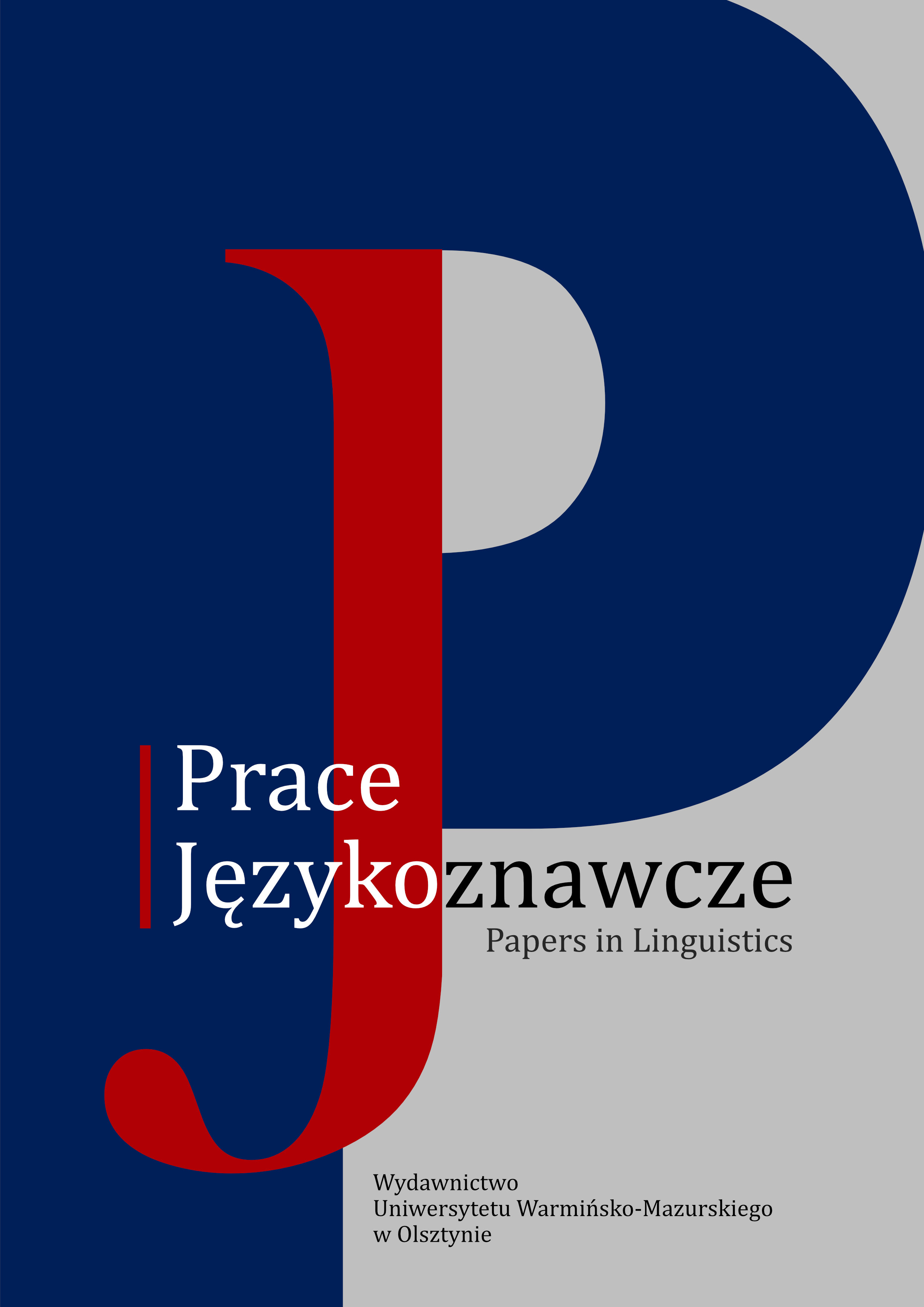Mandarin Chinese 是……的 shì…de construction as an example of a cleft structure
Sebastian Wielosz
Uniwersytet Jagielloński w KrakowieAbstract
Cleft sentences appear in a lot of languages, no matter which language group or family
they represent, yet they might have different syntactic and semantic properties due to
the typological variety of world’s languages. The majority of articles and monographs on
this topic have been written to recount a certain grammatical relation in English, as this
is the language in which the term cleft sentence was coined. Linguists noticed years ago
that similar structures exist in other languages. Among them there is Mandarin Chinese,
which has a structure that meets all the requirements for a frame structure. Yet linguists
do not often see the resemblance between the是……的 shì...de construction and analogical
sentence structures in other languages and do not attribute the name cleft sentence to it.
The main purpose of this paper is to elaborately present what cleft structures are, as well
as to prove that the 是……的shì...de structure is in fact this type of sentence. The first part is supposed to provide general information concerning cleft structures in a natural
language. The second part is a presentation of most important issues related to the cleft
structure in Mandarin Chinese.
Keywords:
frame structure, cleft sentence, emphatic structure, topic-comment sentenceReferences
Bogusławski A. (1973): O rozczłonkowaniu treściowym wypowiedzenia. [W:] Semiotyka i struktura tekstu. Red. M.R. Mayenowa. Wrocław–Warszawa–Kraków–Gdańsk, s. 63–70. Google Scholar
Bogusławski A. (1977): Problems of the Thematic-Rhematic Structure of Sentences. Warszawa. Google Scholar
Chafe W.L. (1976): Giveness, Contrastiveness, Definiteness, Subjects, Topics, and Point of View. [W:] Subject and Topic. Red. C.N. Li. New York–San Francisco–London, s. 25–56. Google Scholar
Collins P. (1991): Cleft and Pseudo-Cleft in Constructions in English. Londyn. Google Scholar
Fichtner E.G. (1993): Cleft sentences in English: A comprehensive view. “Word” 44(1), s. 1–30.
Crossref
Google Scholar
Fowler H.W. (1906): The King’s English. Oxford. Google Scholar
Haartman K., Veenstra T. (red.) (2012): Cleft structures. Amsterdam–Philadelphia.
Crossref
Google Scholar
Hedberg N. (2000): The Referential Status of Clefts. “Language” 76(4), s. 891–920.
Crossref
Google Scholar
Huddleston R., Pullum G.K. (2012): The Cambridge Grammar of the English Language. Cambridge. Google Scholar
Huszcza R. (1983): O pewnych uniwersaliach w tematyczno-rematycznej strukturze zdania. [W:] Tekst i zdanie. Zbiór studiów. Red. T. Dobrzyńska, E. Janus. Wrocław–Warszawa–Kraków–Gdańsk–Łódź, s. 97–124. Google Scholar
Huszcza R. (1990): Tematyczno-rematyczna struktura zdania w językach różnych typów. (Normalny podział tematyczno-rematyczny). [W:] Tekst w kontekście. Zbiór studiów. Red. T. Dobrzyńska. Wrocław–Warszawa–Kraków, s. 55–96. Google Scholar
Jesperson O. (1937): Analytic Syntax. Chicago. Google Scholar
Kisiyarno H., Sarage J. (2015): English and Arabic Cleft Sentences as Subject Prominence. “International Journal on Studies in English Language and Literature” 3(12), s. 1–5. Google Scholar
Kiss K. (1998): Identificational Focus versus Informational Focus. “Language” 74(2), s. 245–274.
Crossref
Google Scholar
Künstler M.J. (2000): Języki chińskie. Warszawa. Google Scholar
Li C.N., Thompson S.A. (1976): Subject and Topic: A New Typology of Language. [W:] Subject and Topic. Red. C.N. Li. New York–San Francisco–London, s. 457–490. Google Scholar
Li C.N., Thompson S.A. (1989): Mandarin Chinese. A Functional Reference Grammar. Los Angeles. Google Scholar
Lin H.T. (2005): Essential Grammar For Modern Chinese. Boston. Google Scholar
Lin J.X., Shu Z.M. (2013): 华语文教学之汉语语法学论文 Huáyǔ wén jiàoxué zhī hànyǔ yǔyán xué gàilùn. Taibei. Google Scholar
Mathesius V. (1971): O tak zwanym aktualnym rozczłonkowaniu zdania. [W:] O spójności tekstu. Red. M.R. Mayenowa. Przekład M.R. Mayenowa. Wrocław–Warszawa–Kraków–Gdańsk, s. 7–12. Google Scholar
McCloskey J. (1979): Transformational Syntax and Model Theoretic Semantics: A Case Study in Modern Irish. London.
Crossref
Google Scholar
Menuzzi S., Teixeira M. (2015): Diverse exhaustiveness effects in cleft sentences: A descriptive study. “Alfa: Revista de Linguistica” 59(1), s. 61–91.
Crossref
Google Scholar
Nakamura C. (2004): On the cleft sentence and the nominalized sentence in Irish, “Kyoto University Linguistics Research” 23, s. 47–62. Google Scholar
Niimura M. (2007): A syntactic analysis of copular sentences, “Nanzan Linguistics: Special Issue 3” 1, s. 203–237. Google Scholar
Pelc J. (1991): Prace z pragmatyki, semantyki i metodologii semiotyki. Wrocław. Google Scholar
Polański K. (red.) (1993): Encyklopedia językoznawstwa ogólnego. Wrocław. Google Scholar
Sun C.F., Zhan F.Q. (2013): A Copula Analysis of shì in the Chinese Cleft Construction. “Language and Linguistics” 14(4), s. 755–789. Google Scholar
Tajsner P. (2015): On focus marking and predication. Evidence from Polish with some notes on Hausa. “Lingua Posnaniensis” 57(1), s. 113–138.
Crossref
Google Scholar
Traugott E.C., Zhan F.Q. (2015): The constructionalization of the Chinese cleft construction. “Studies in Language” 39(2), s. 459–491.
Crossref
Google Scholar
Zajdler E. (2010): Glottodydaktyka sinologiczna. Warszawa. Google Scholar
Zheng Y., Cao F.F. (2012): 华语句法新论, 下 Huáyǔ jùfǎ xīn lùn, xià. Taibei. Google Scholar
Uniwersytet Jagielloński w Krakowie
License

This work is licensed under a Creative Commons Attribution-NonCommercial-NoDerivatives 4.0 International License.





